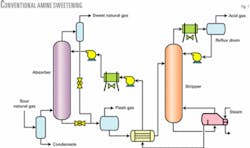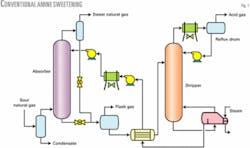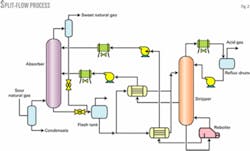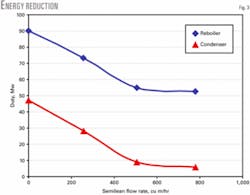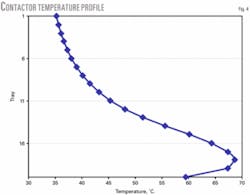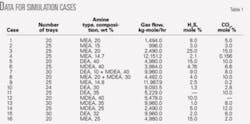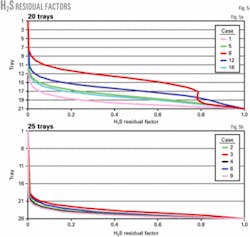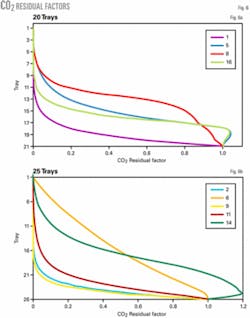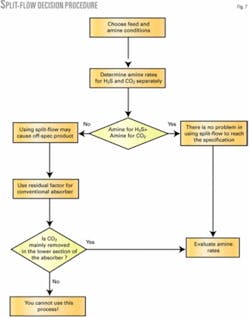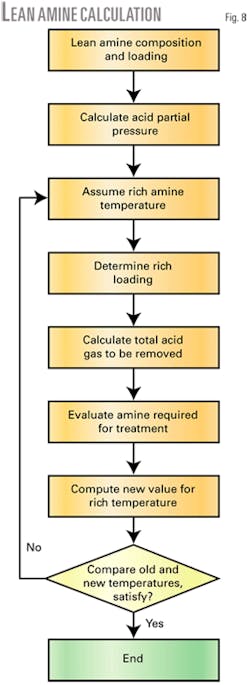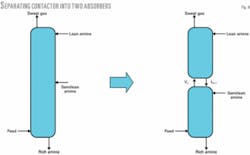Method calculates lean, semilean streams in split-flow sweetening
Alkanolamines are used widely in gas treating plants. Because acid-gas removal from natural gas requires regeneration of alkanolamines, the energy requirement for the stripping section (condenser and reboiler) will be much greater when the inlet sour gas contains a high concentration of acid gases.
In these cases, a split-flow process can reduce energy consumption. Two solvent streams called lean and semilean streams are used.
A new method has been devised for calculating these stream rates. The procedure is based on simplifying assumptions that permit quick shortcut calculations.
The proposed method has been tested for two plants, the Okotoks sweetening plant in Canada and the Razi petrochemical complex in Bandar Imam Khomeini, Iran, with acceptable results achieved.
Natural gas sweetening
Natural gas, one of the most important energy sources, contains light hydrocarbons (predominantly methane) and some contaminants. From these contaminants, hydrogen sulfide and carbon dioxide should be removed because of health and environmental problems and to lower transmission costs.
Several sweetening technologies exist. Among these, alkanolamines are the most widely used solvents for absorbing H2S and CO2 and have been used since the 1930s.
Fig. 1 shows a basic flow scheme for alkanolamine treating. Inlet gas that usually contains CO2 and H2S enters the absorption section and contacts a lean amine stream in the column.
Amine solvent absorbs acid gases and leaves the contactor bottom as rich amine. The sour gas loses acid gas contaminants and flows from the contactor top as sweet gas.
Rich amine passes through a flash drum and lean-rich heat exchanger. The stream then enters the regenerator column. In this section, acid gases are released from the amine and leave the tower’s top; high-temperature regenerated amine is drawn from the regenerator as bottom stream.
After being cooled and pumped, this lean amine stream enters the absorber.
Modifications
Some modifications can improve the operating conditions and enhancement in gas treating.
All of these modifications fall into four configurations:
- Adding a precontactor in the path of sour gas.
- Using multiple feed points in the absorber.
- Using a split-flow configuration in which semilean amine is fed to some midpoints of the absorber while ultralean amine is fed at the top (Fig. 2).
- Installing pressure-swing regeneration instead of reboiling.
All of these modifications have advantages and drawbacks. Gas treating with split-flow has a greatly reduced energy use in the plant. In the conventional process, all amine leaving the contactor is regenerated; in the split-flow process, some solvent is withdrawn from the regenerator (partially stripped) and enters the midpoint of the contactor for bulk removal of acid gases.
This means that the bulk of absorption is a compulsory condition of using the split-flow process in gas-treating plants. There are no major changes in the total amine flow rate, but because the stream from the regenerator has a lower amine composition, the total circulation rate is greater than before.
If the processor decides to treat sour gas with the split-flow process, a calculation algorithm based on the conventional procedure can be used to calculate the required lean and semilean amine flow rates.
Fig. 3 shows the semilean amine flow rate and the effect on the condenser and reboiler duties in the stripping column of the Razi petrochemical complex’s (RPC) gas-treating plant. These rates are calculated with Amsim1 as sweetening simulation software and our proposed procedure.
For a specific case, we simulated the conventional and semisplit flow. At a semilean flow rate of zero (conventional amine process), we calculated the lean amine rate at about 790 cu m/hr. The stripper and condenser duties were about 90 Mw and 47.7 Mw, respectively.
In the split-flow process, these duties are reduced to 54.5Mw and 8.6 Mw with lean and semilean flow rates of 390 cu m/hr and 507 cu m/hr, respectively. Due to the higher solvent rates for the split-flow case, a larger unit is needed.
Split-flow processing
The main concept in split-flow is that most of the acid gases are removed from sour gas in the contactor’s lower section. Because absorption with amines is an exothermic reaction, the temperature of liquid across the column increases when flowing down through the trays.
Fig. 4 shows a typical temperature profile across the column.
The temperature profile, however, is an unsuitable way to monitor absorption effectiveness. A parameter is needed to show the amount of absorption in the tower. This parameter can be more useful if it is independent from the feed composition and rate, amine rate, and type of amine and composition.
We propose using a parameter called the residual factor, defined as the difference between the vapor composition of the gas leaving each stage and sweet gas divided by the difference between sour and sweet gases compositions:
Residual factor = (ym-y1)/(yn+1-y1)
Where y1 is the composition of a specified component in the sweet gas, ym is the composition of a specified component in gas leaving stage m, yn+1 is the composition of a specified component in the sour gas, and n is the number of stages in tower.
This factor varies between 0 and 1; it is 0 at the top and 1 at the bottom.
We simulated and studied 16 different cases to obtain a general trend or algorithm. In these cases, different feed rates, compositions, and amine types were tested for different columns. We used 20-30 trays in the simulation; this is common in the gas-treating industry. Table 1 shows the cases that we simulated.
We calculated removal efficiencies for each component (H2S and CO2) in each stage with the Amsim software using a rate-based method.
Figs. 5 and 6 show H2S and CO2 composition profiles and residual factors for selected cases.
Most H2S absorption curves behave similarly and normally, which we call “normal” cases. Some of them deviate from normal behavior, which we refer to as “abnormal” cases.
In normal cases, most absorption occurs in the absorber’s lower section. The gas temperature and acid-gas composition rise and fall rapidly, respectively. In the abnormal cases (Cases 6, 8, and 14), however, there is a noticeable deviation in H2S absorption. After careful observation, we found that in these cases, absorption of CO2 controls the amine circulation rate. In other words, the total rate of required amine to absorb the CO2 is greater than the rate of required amine for H2S removal.
Fig. 6 shows that some of the curves change gradually due to the same reason. Our calculation procedure, therefore, is based on the assumption that most absorption occurs in the column’s lower section. The procedure’s first assumption, however, is that H2S should control the amine rate.
When CO2 controls the amine rate, however, the procedure requires some revisions and extra attention. One must check the composition profile to see if most absorption is obtainable in the lower section. The residual factor is an excellent tool for this purpose. Then, the entire calculation sequence should be performed exactly the same as that of H2S.
Fig. 7 shows the procedure to evaluate the possibility of applying the split-flow process.
Calculation procedure
This procedure shows how to calculate amine rates for H2S and CO2 (Fig. 8):
1. Assume a lean stream composition. It may be free of acid gases assuming complete regeneration in the stripper. In other words, lean amine loading equals 0. Use the actual lean stream composition if available. Fitzgerald and Richardson proposed extracted loading of monoethanolamine depending on the steam consumption, or it may be available from real plant data.2
2. Determine partial pressures of H2S and CO2 in the feed sour gas and assume an appropriate temperature for the rich amine stream.
3. Calculate the rich amine loading using either experimental data and charts or a computer calculation. Some experimental data are available in the literature or simulation software may be used. EzSweet software, developed for amine gas sweetening processes, can estimate solution loadings in equilibrium with acid gases.3
Corrosion due to high acid-gas loading is a limitation to consider, especially in spilt-flow processes in which inlet sour gas contains large amounts of acid gases.4 5 In our study, the maximum allowable loading is 0.5 mole H2S /mole amine for the RPC and Okotoks gas-treating plants. This value is from the plant operating guidelines.
Maximum loading should otherwise be at the discretion of the designer to avoid corrosion problems during operation.
4. Calculate the total amount of H2S and CO2 that must be removed from natural gas. A good assumption is that all of the acid gases will be absorbed. For example, for primary and secondary amines, there is a trace residual amount of CO2 and H2S in the sweet gas. But we can neglect this amount because no major differences in the results occur.
5. Divide H2S and CO2 rates by the loading of these compounds and determine the amount of necessary amine for absorbing acid gases.
6. Perform an energy balance around the absorber or use a simulation program to recheck the assumed temperature of rich amine. This is important for calculating the loading of acid gases. If the difference is not small enough, repeat the second step.
Shortcut method
The most important part of this procedure is dividing the absorber into two separate columns (Fig. 9). Liquid from the top section enters the lower section and vapor from the lower section enters the top section.
Using this simple shortcut method separates easily the total mass balance into two mass balances.
Here are the steps in this method:
1. Assume that 99.5% of the H2S is absorbed in the lower section. Calculate the amount of H2S in stream Vn. This value (99.5%) is reasonable. The amount of H2S in this stream should be absorbed by the lean amine.
2. Assume that a portion of the required amine calculated in the conventional calculation enters as lean amine into the column’s top section. A good initial value is half of the total amine. This value can be corrected if necessary when optimizing.
3. Calculate loading of stream Ln-1. Assume that the total H2S in stream Vn is removed by lean amine and is available in stream Ln-1.
4. Assume that the loading of stream Ln-1 and the semilean stream are close in composition. This may not be true in reality but it is the best assumption for a quick calculation. If the semilean stream loading is available from past experience or plant data, results will be better.
Assume also that loading and temperature of the rich amine solution calculated in the conventional process calculation are equal to loading and temperature of rich amine in this part and calculate the total required amine in rich stream.
5. Evaluate the flow rate of amine in the semilean stream. This rate of amine is the sum of amine in lean and semilean streams.
Simulation results
We tested two cases-RPC, Iran, and Okotoks, Alta.-to demonstrate the application and accuracy of the proposed method. Furthermore, we have studied a third, unnamed case to demonstrate reliability of the proposed method.
Table 2 shows the conditions for three case studies and Table 3 shows the results of the three case studies.
The calculation method shows good agreement with plant data.
Determination of the lean amine rate for conventional amine treating plant is well known and straightforward. For split-flow gas treating, however, calculations of lean and semilean stream rates are complex.
This method eliminates the complex computations that have been done in the past for simple absorptions.6 7 Some simple assumptions prevent tedious calculations. This procedure is appropriate and applicable to estimate amine solvents at the design stage of the plant or during optimization procedure. It can also be used to determine lean and semilean streams rate for an operating plant.
References
- Amsim, Acid gas removal by amine simulator, version 7.2, 2003, Oilphase-DBR and Schlumberger, Canada.
- Fitzgerald, K., and Richardson, J.A., “How Gas Composition Affects Treating Process Selection,” Hydrocarbon Processing, July 1996, Vol. 45.
- Moshfeghian, M., and Maddox, R.N., “EzSweet: Sour Gas Sweetening Simulation Program,” private communication, 2007.
- Pearce, R.L., and Dupart, M.S., “Amine inhibiting,” Hydrocarbon Processing, May 1985.
- Abry, R.G.F., and Dupart, R.S., “Amine Plant Troubleshooting and Optimization,” Hydrocarbon Processing, April 1996.
- Wang, M., Chang, R., and Cheau, T., “Analysis of Absorption-Stripping Processes with Split-flow Cycles for Energy Saving,” Journal of Chinese Institute of Chemical Engineers, Vol. 16 (1985), pp. 1-9.
- Wang, M., and Wei, S., “Energy Conservation of Absorption-Stripping Processes with Split-flow Cycles,” Journal of Chinese Institute of Chemical Engineers, Vol. 15 (1984), pp. 111-20.
The authors
Vahid Mohebbi ([email protected]) is a research engineer at Research Institute of Petroleum Industry (RIPI), Iran. He holds BS from AmirKabir University in chemical engineering and MS from Petroleum University of Technology in gas processing and transmission engineering.
Reza M. Behbahani ([email protected]) is a faculty member of the Petroleum University of Technology, Iran. He received his PhD in 2003 from University of Surrey, Guildford, UK. His main research interests are fouling in heat exchangers, thermodynamics, gas processing and process simulation. Currently, he is the head of Gas Engineering Department of the Petroleum University of Technology, Iran.
Mahmood Moshfeghian ([email protected]) is a senior research engineer at John M. Campbell & Co., Norman, Okla. Before joining JMC, he was professor of chemical engineering at Shiraz University, Iran, where he served as department head and associate dean of research in the college of engineering. He was previously professor of chemical engineering at the University of Qatar and a senior research scientist at the Kuwait Institute for Scientific Research. Moshfeghian holds BS, MS, and PhD degrees in chemical engineering from Oklahoma State University. He is a member of AIChE.
